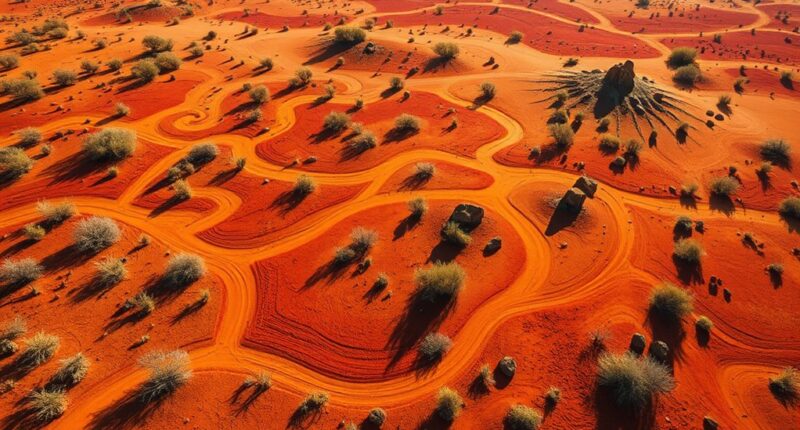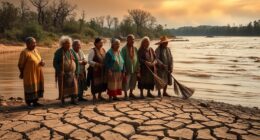You discover that songlines are oral maps where language and landscape are deeply connected. As you follow the stories, you realize they encode geographic features, waterholes, and sacred sites, guiding travelers across vast land without maps. These songs aren’t just stories—they’re living guides rooted in spirituality and cultural history. By understanding these songlines, you see how language preserves the land’s essence and spiritual meaning. Continue exploring, and you’ll uncover even more about this remarkable navigation system.
Key Takeaways
- Songlines are oral maps encoded in Dreamtime stories that link language, land features, and spiritual beliefs.
- Indigenous languages embed geographic details, allowing navigation through storytelling rather than written symbols.
- Stories connect physical landmarks with spiritual significance, guiding travelers along ancestral pathways.
- Language preserves sacred site knowledge and seasonal movements, ensuring cultural continuity across generations.
- The intertwining of language and landscape creates a holistic system for navigation, cultural identity, and spiritual connection.

Have you ever wondered how ancient Aboriginal Australians navigate vast landscapes without maps? It’s a question that taps into a rich tradition of Indigenous navigation, where the land itself becomes a living map. Central to this knowledge are Dreamtime stories, which serve as oral maps passed down through generations. These stories aren’t just myths; they encode detailed geographic information, connecting specific landmarks, waterholes, and spiritual sites into a cohesive system. When you learn about Indigenous navigation, you realize it’s not just about moving through space but about understanding a spiritual landscape that’s intertwined with history, culture, and identity.
Dreamtime stories are the foundation of this navigation system. They recount the origins of the land, the ancestors’ journeys, and the creation of natural features. By memorizing and reciting these stories, Aboriginal people can recall exact routes across the land, even in unfamiliar territory. Each story acts like a chapter in an oral map, guiding travelers from one significant site to another. Unlike a Western map, which relies on symbols and coordinates, these stories embed geographic cues within narrative, making them an intuitive and dynamic way to navigate. You might hear about a particular song or chant linked to a waterhole or a mountain, serving as a verbal signpost to help travelers find their way.
Indigenous navigation hinges on this deep connection between language, land, and spirituality. The stories are more than oral histories—they’re living guides that encode spatial relationships, seasonal movements, and sacred sites. When someone follows a songline, they aren’t just traveling physically; they’re retracing ancestral pathways that connect the land’s physical features with its spiritual essence. Additionally, understanding the importance of Puppy Socialization and its role in fostering adaptability can be metaphorically linked to how these stories adapt and evolve over generations to maintain their relevance and accuracy. This system guarantees that knowledge remains within the community and is passed down accurately through generations, preserving the landscape’s sacred significance.
Frequently Asked Questions
How Do Songlines Evolve Over Centuries?
You might wonder how songlines change over centuries. They evolve through complex evolutionary pathways, influenced by cultural transmission across generations. As communities pass down stories and songs, these pathways adapt, reflecting shifts in environment, language, and social ties. This ongoing process guarantees songlines remain relevant, preserving cultural identity while integrating new experiences, making them dynamic maps of history and land that grow richer with each passing century.
Are Songlines Unique to Indigenous Australian Cultures?
Did you know that songlines are mainly unique to Indigenous Australian cultures? These oral traditions hold immense cultural significance, serving as navigational tools and storytelling methods passed down through generations. While other cultures have oral traditions, the way Indigenous Australians intertwine language and landscape through songlines is distinct, making them a crucial part of their cultural identity and connection to the land.
Can Songlines Be Mapped Using Modern Technology?
You might wonder if songlines can be mapped with modern technology. While cartographic challenges exist due to their oral and experiential nature, technological integration offers promising solutions. Using GPS, GIS, and digital mapping, you can visualize these intricate pathways. However, capturing their cultural and spiritual significance remains complex, requiring respectful, detailed approaches that honor their deep connection to land and language.
What Is the Role of Storytelling in Preserving Songlines?
Storytelling acts like a river flowing through time, carrying cultural continuity and preserving oral traditions. You pass down songlines through stories, ensuring their survival across generations. When you share these tales, you weave a rich tapestry of history, language, and landscape that keeps the connection alive. This living tradition allows you to honor your ancestors, strengthen identity, and keep the intricate web of songlines vibrant and enduring for future generations.
How Do Songlines Influence Contemporary Australian Identity?
You see how songlines shape contemporary Australian identity by maintaining cultural continuity through oral traditions. They connect you to the land and ancestors, reinforcing a shared sense of history and belonging. These stories are more than memories; they’re living expressions of identity that adapt over time, ensuring the cultural heritage remains vibrant. By honoring songlines, you help preserve a unique cultural fabric that defines modern Australia’s diverse and enduring spirit.
Conclusion
You might not realize it, but nearly 80% of Indigenous Australians still follow songlines to navigate their land. These ancient pathways, woven through language and landscape, preserve stories and culture across generations. By understanding this deep connection, you see how language isn’t just words—it’s a living map. Embracing these traditions reveals the profound ways humans align with nature, reminding us that our stories and landscapes are truly intertwined.









